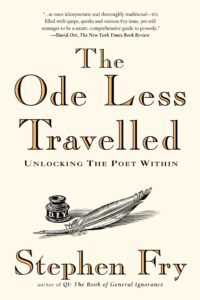Stephen Fry on Meter, Part 1
 As I mentioned previously, I’m working through Stephen Fry’s The Ode Less Travelled very slowly to absorb as much wisdom as I can about writing poetry. This week’s post covers Chapter 1, Section 1, on spoken English, meter, and iambic pentameter.
As I mentioned previously, I’m working through Stephen Fry’s The Ode Less Travelled very slowly to absorb as much wisdom as I can about writing poetry. This week’s post covers Chapter 1, Section 1, on spoken English, meter, and iambic pentameter.
The beginning of this chapter talks a lot about stressed and unstressed syllables, and how things that work in English don’t work in, say, French, because French doesn’t really DO stressed and unstressed syllables in the same way as English (see also this Tom Scott video on why Shakespeare couldn’t have been French). Despite having studied a lot of French throughout my schooling, this never really occurred to me. It also made me think about how some French forms of poetry might be more complicated in English, since the French poems wouldn’t really have meter in the same way.
The chapter then talks about how poetry uses meter as an organized rhythm, and the various types of meter units that exist with two syllables. There, you learn about iamb, trochee, spondee, and pyrrhic units. And then, building on this, he explains iambic pentameter as simply five iamb units. Breaking it all down like this was very helpful to me, as I could see how each of the types of units worked, and then have the realization of “oh, you can just throw five together, and boom, iambic pentameter.” It’s always been that easy, but there’s something about the way he explained it that finally got it into my brain.
There are a couple of exercises in this chapter, one for reading iambic pentameter to get the feel for it, and one for writing lines of iambic pentameter about whatever, and not trying to link them all together as a poem. A couple of samples from what I wrote:
- My cat is black as night and purrs like storms.
- I’m counting clothespins, coming up with eight.
- A chirp above our heads says spring is sprung.
- Within the dragon’s lair lay stacks of bones.
- The television tuned to static snow.
I’m not saying there’s anything great there, but getting the practice was helpful for playing around with words and seeing what I could do with words that were more than one syllable. Looking at what I wrote, a lot of it just uses one or two syllable words, but the final line has a four syllable word. (And some of the others worked with three and four syllables too.) Playing around with where the stress fell in a word was illustrative of how people say words naturally and how they might sound if you switched the stress (very weird!).
The next section will do more with meter, and while I’m already feeling intimidated by the section topics (which includes things like enjambment and caesura, which are NOT things I think I’ve ever learned about), I think, based on what I’ve read so far, that they’ll start making sense as he breaks them down in his easy reading style!

Comments